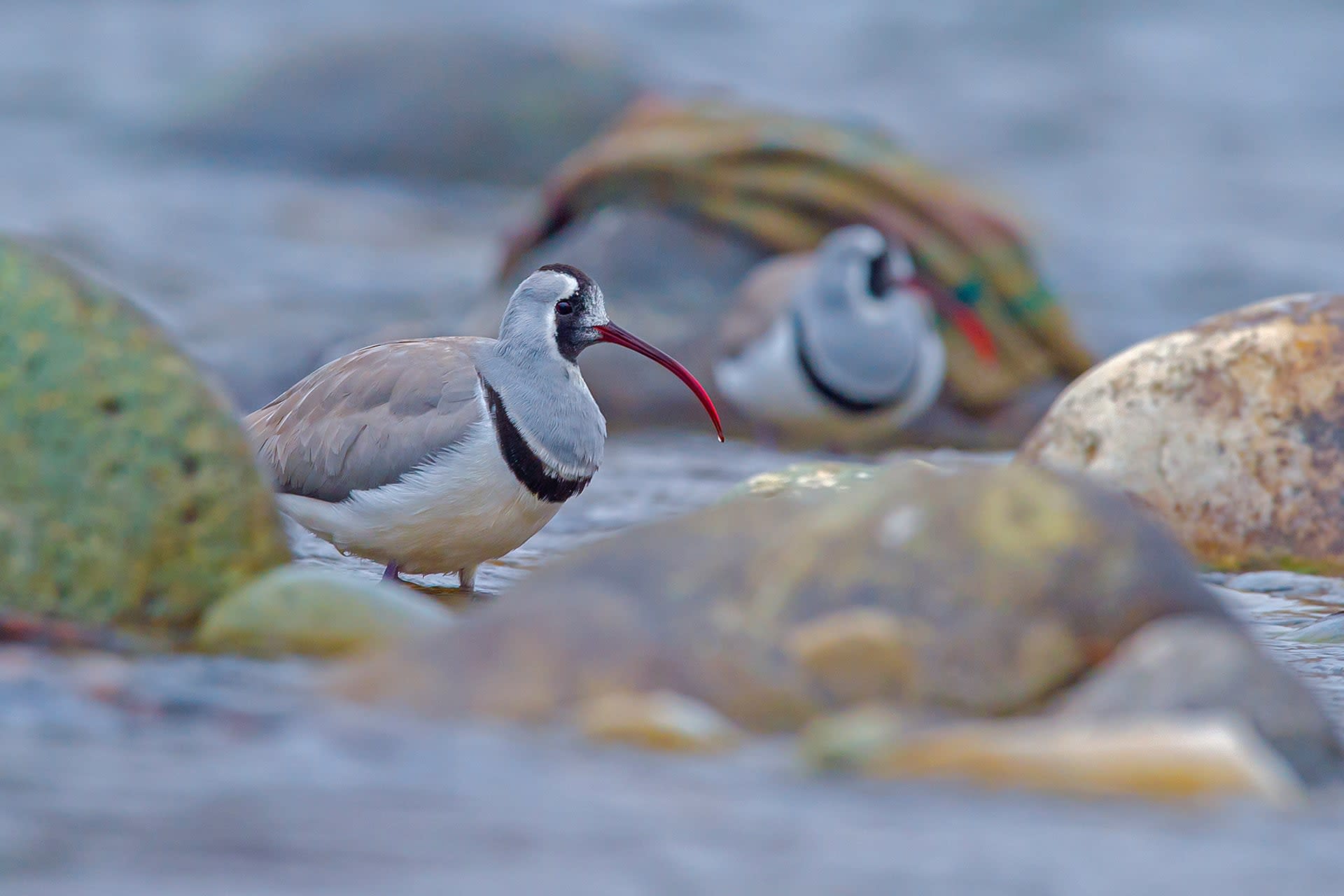 Listen to this article
•
15:34 min
Listen to this article
•
15:34 min
The Sindh River flows quiet and clear under a grey December sky. At the margins of its channel, men hack away with pickaxes and shovels, extracting sand and boulders from the riverbed. A tractor backs up to the water’s edge and its trailer is loaded to the brim. Then it chugs off into the distance, and another takes its place. Again and again, tractors come down to the riverbanks, leaving with their bellies full.
I register all this peripherally because Iqram has asked me to focus on one particular part of the riverbed: an area with small round boulders, one of which is now, suddenly, behaving as boulders ought not to — it is moving of its own accord, turning towards us. In profile, a long, crimson, down-curved beak manifests. Then a black face, white belly, and black crescent breastband appear: all characteristic of the ibisbill (Ibidorhyncha struthersii).

Cover Photo: Although the ibisbill’s conservation status is of “Least Concern” globally, a recent study has found that it faces significant anthropogenic threats in the Kashmir-Ladakh region. Photo: Dhritiman Mukherjee
We are at Kijpora Kangan in the Ganderbal district of Jammu and Kashmir, near the well-known Dumping Park (presumably named after the massive rubbish heap that abuts it). This is one of the sites along the Sindh where Iqram ul Haq (PhD, a freelance researcher formerly with the Biodiversity Conservation Lab, Department of Zoology, Kashmir University) has been studying the ibisbill’s ecology. The bird is a wader (Order: Charadiiformes) but occupies a distinctive family (Ibidorhynchidae), of which it is the only member. It is typically found in high-altitude shingle-bed rivers across southern Central Asia, feeding and nesting amidst pebbles, cobbles, and boulders on banks and islets in flat areas with moderate water flow.
Studying a species evaluated as “Least Concern” on the IUCN Red List wasn’t Iqram’s first thought when he considered his PhD research; he was more interested in exploring the impact of mesocarnivores on the population of the “Critically Endangered” hangul (Cervus hanglu hanglu). A meeting with Dr Asad Rahmani of the Bombay Natural History Society (BNHS) in March 2017 shifted his focus towards lesser-known species and, ultimately, the ibisbill. But studying the bird would be quite a challenge: very little research had been conducted across its global range (there was just one study from southwest China, published in the journal Waterbirds in June 2013, and records of its presence in Kashmir were limited.)

Growing Concern
In September 2017, Iqram began a preliminary survey along the Sindh in Ganderbal and Ladakh, during which Dr Rahmani and he sighted five ibisbills near Sonmarg. Subsequently, field surveys were conducted along other rivers in Kashmir. High and low probability ibisbill locations were then derived for the entire Kashmir and Ladakh region through a method called maximum entropy modelling (using probable presence and exact presence data from the field with added layers such as temperature, precipitation, river flow, etc). The probable locations thus obtained were ground-truthed (i.e., the accuracy of the remotely sensed data was checked through observations). The main focus was along the Sindh (Ganderbal) and Lidder (Anantnag) rivers, besides the Gurez Valley, Zanskar Valley, Kargil, and Leh.
Since the literature on the Ibisbill was so limited, field observations were crucial. For nearly two years, Iqram and his colleagues spent all their waking hours watching the bird, documenting every movement, every behaviour. The results of their research between 2017 and 2019 were published as a paper in the journal Ornis Hungarica (June 2022). Crucially, this paper revealed several clear and present threats to the ibisbill in the Kashmir-Ladakh region: sand and boulder mining being the most pernicious, followed by vehicular movement, and the presence of locals/tourists near riverbeds, livestock grazing, and predation by free-ranging dogs. “Now, having seen the ground reality of the species”, Iqram says, “we know that it is surviving with great difficulty.” Indeed, he has observed firsthand how pervasive sand and boulder mining is across ibisbill habitats. He has witnessed the predation of chicks by black kites, whose population may be increasing due to the open garbage dumping near rivers. He has seen eggs trampled by sheep and nests washed away by increased water flow caused by greater-than-usual glacial melt.
The ibisbill is a (habitat) specialist, which means it has incredibly specific environmental needs to survive. The bird has morphological adaptations specific to the areas it typically inhabits; it is also intolerant of water quality deterioration and can be regarded as an indicator species (reflecting the health of their environment). “The problem”, Iqram points out, “is that its habitats fall outside the Protected Area network and designated Important Birding Areas.” Protecting these habitats is particularly challenging, therefore, and requires support from the union territory administration, apart from the Department of Wildlife Protection. A technical note sent to the District Commissioner, Ganderbal, did bear fruit in March 2023, with an immediate order passed to ban sand and boulder mining during the breeding season at nesting locations on the Sindh. Iqram feels this undoubtedly had an impact on hatching success last year.

Meanwhile, his research on the ibisbill continues. His team was able to tag two birds with lightweight platform terminal transmitters (PTTs) last year — the first such tagging exercise, globally, for the ibisbill — which should provide valuable data on home range, dispersal, and movement patterns. Another study on the potential impacts of climate change on the bird’s habitats will provide further insights.
Research will help us learn more about this elusive bird and outline specific conservation measures. However, given that its habitats are unprotected and the major threats are caused by human activity, saving the ibisbill will require political will and administrative action. “As a researcher”, Iqram says, “I am invested in the species’ conservation. But its future depends on the people who hold the reigns of conservation in Kashmir and Ladakh.”







